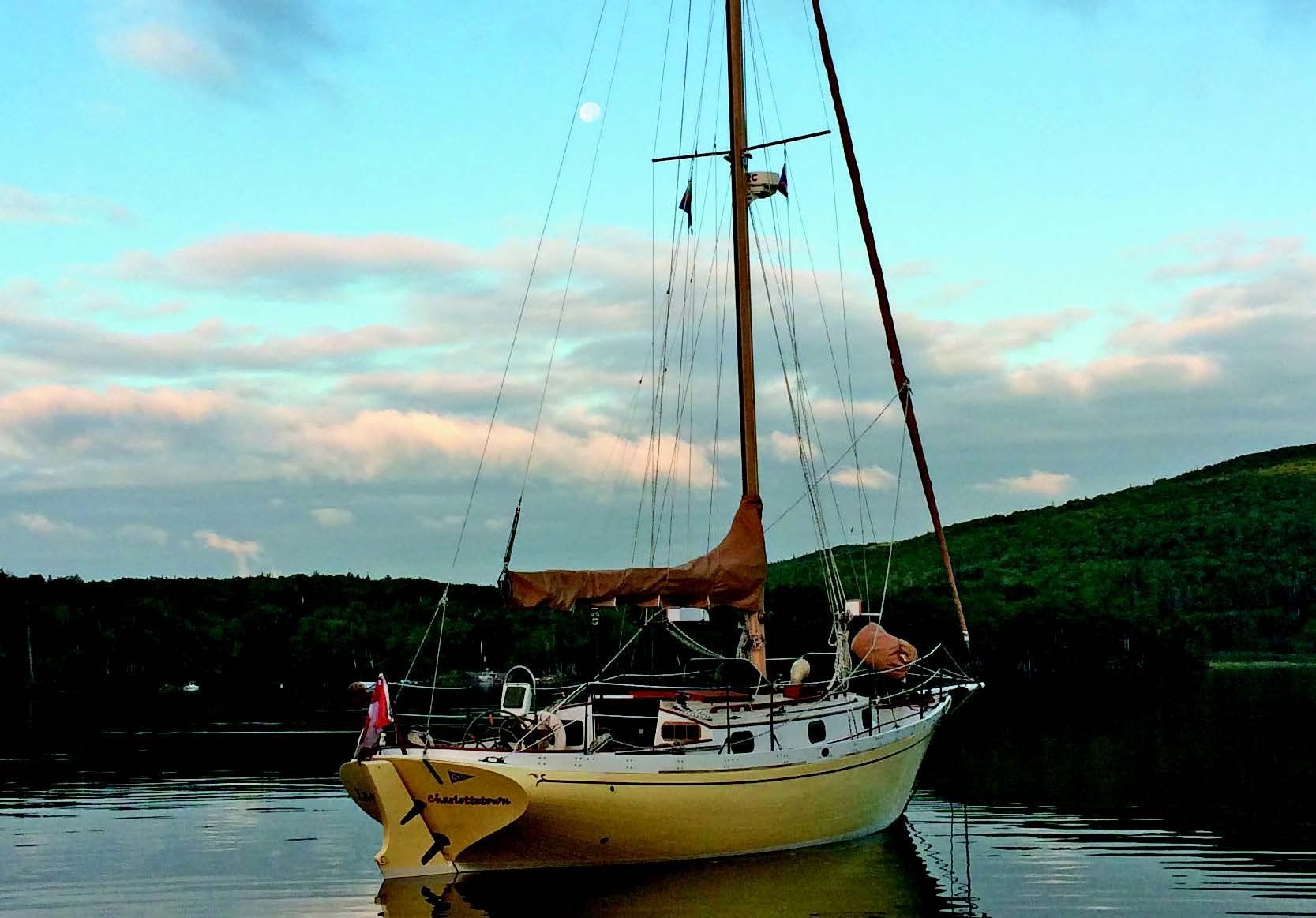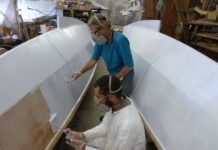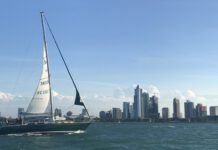Water Purification on Lake Michigan
Would a filter like the one you featured recently (Effective Affordable Water Filter, PS October 2013 online) be able to make lake water safely drinkable?
We race a Tartan Ten out of Montrose Harbor, Chicago. Since were sailing on fresh water and the Chicago Area Sail Racing Association doesn’t require us to have a built-in tank for offshore racing, the water tank was removed long ago to eliminate excess weight. For port-to-port racing, we usually buy jugs of bottled water and refill individual water bottles. For round-the-buoy racing, we bring water bottles. Some of the T10s just use a camping-type water filter. We recycle the water bottles, but if a filter worked, we could cut down on these-a big plus.
David Brezina
Tartan Ten, Ratty
Montrose Harbor, Chicago
Photos courtesy of David Brezina

The short answer is probably, but to be safe wed take a couple extra steps. Theoretically, a filter that meets the National Science Foundation (NSF) P231 standards will be sufficient to make Lake Michigan drinkable.
A more effective (but less practical and more expensive) choice would be to use a filter that meets the more stringent NSF 53 standard (see Making Sense of Water Filters, PS August 2016). Although the General Ecology filter that you are referring to (see Effective, Affordable Water Filters, October 2013) is not NSF certified, the company claims to have passed the relevant tests.
If you wanted to be even more certain your water is clean, you could look for high-volume systems like the Katadyn Exstream billed for use in third world expeditions, but these cost as much as a watermaker. A more cost-effective way to get a high level of protection would be to use a three-step process that we outlined in our series on treating onboard drinking water. This is what we would recommend for you. The process would be easier to carry out if you had a portable tank. We have tested several flexible potable-water tanks that would serve well (see Practical Sailor Drags, Drops, and Dissects Three Flexible Potable-Water Tanks, PS October 2002).
First, you need to prefilter the water to remove dirt before it goes into the tank. The 1-micron Baja Filter that we wrote about in 2015 is a favorite tool for this, but we looked at various other filters that will prevent solids from getting into the tank (see Water Tank Filters, PS June 2015). Clean water is required for the next essential step, chlorine treatment.
Chlorine treatment will kill viruses and bacteria. Although regular liquid chlorine will work, it isn’t ideal for storing aboard. We found pool and spa chlorination tabs to be a convenient alternative for chlorinating tank waters (see Keeping Water Clean and Fresh, PS July 2015). The key to any chlorination regimen is using the right amount of active ingredient. You should use only enough chlorine to leave a one part per million (PPM) residual chlorine after one hour. You can use a pool test kit, or aquarium test tape strips to check residual chlorine.
Finally, you need to filter before the tap with a filter element that is rated to remove cysts such as giardia and cryptosporidium. Weve tested several filters that are rated as microbial purifiers, meeting the P231 standard. These filters are capable of removing all viruses and bacteria. Last but not least, if you have a permanently installed tank, don’t forget to secure the vent. The freshwater tank should have a #20 mesh screen to keep bugs out.
Although this multistep step process might seem like overkill, it is very similar to that used by municipalities that draw their water from the Great Lakes. It is still possible that naturally occurring algae blooms can introduce toxins that these steps wont catch, but this is very unlikely. Because these toxins pose a threat to drinking water supplies, their occurrence is usually monitored by local municipalities and reported in the local press.
Photos courtesy of Greg Ross

Fuel Tank Cleaning
My experience with microbial contamination has led to discovering much of whats laid out in your recent Rhumb Lines article (see Dealing with Bad Diesel PS June 2017). I began with the addition of two additional tank top access ports to get access to all three chambers of the tank. Two ports were needed because the tank had baffles built into it. My boat had been laid up for four years, with indoor storage. I presume warm summer temperatures over that interval had promoted quite an in-tank bloom. The tank was not exceptionally dirty, but the presence of water was promoting the biological activity. I had the good fortune to meet a fuel solutions fellow from Halifax, Nova Scotia who owns Diesel Pure Inc. (www.dieselpure.com) who specialize in fuel polishing systems. The fuel polishing system for my boat is a three-stage arrangement consisting of a primary crud trap, a first-stage, water-type filter followed by 10-micron, second-stage filter, and a two-micron, third-stage Racor filter. A vacuum gage provides visual indication of filter status.
To accommodate this polishing setup, I added a set of inlet/outlet drop tubes that extend to the low corner of the tank, in the same vicinity of the existing fuel pickups. The pump that Ive included in this setup (approximately 6 psi) is to be powered from a timer/solenoid that will run the pump for an hour each day or, on a manual over-ride any time new fuel is taken on. Since the main fuel pickup draws from that low corner of the tank its guaranteed to draw from any pool of water naturally collected there. By drawing from and returning the polished fuel into that same zone I anticipate Ill create sufficient turbulence to agitate and capture the water. As I understand it, the microbial action takes place in the interface zone between fuel and underlying water. Eliminate the water and the microbial activity ceases.
Greg Ross
Ericson Independence 31
South Melville, Prince Edward Island

Using Waterline Snubber
Regarding your recent blog post entitled Rethinking Anchor Snubbers, we have taken a relatively unique approach that has worked well for us. We installed a waterline bow eye and use a nylon snubber on our 46-foot Cal 2-46 Bright Water. It saves unneeded scope, quiets the anchor chain, and softens the jerk as the chain comes tight. Also, the snubber line is mostly underwater, lubricated and cooled. It works perfectly, including winds up to 25- to 35 knots all day, with gusts to 60. We have lots of pictures and discussion on our blog www.svbrightwater.wordpress.com. Im suspicious of the method described in your report. A rope will chafe itself to death from internal movement. Running the line over fixed slides might saw right through it. This is another reason we installed the bow eye, to keep the tensioned line off the gunwales and anchor roller. Another benefit of this method is that anchor and chain noise is almost completely removed from the boat.
We have been forced to pull the anchor and move in winds 45-knot winds. It helps that the Cal 2-46 has a big motor and an even bigger prop, and that the Lofrans Tigres windlass is fast.
Phil Rink, PE
Cal 426 Brightwater
Anacortes, WA
Chafe is always a major concern with snubbers. One of the reasons for a using a long snubber is to reduce the amount of elongation and the resulting internal heat build up as the fibers stretch. In our experience, effective porous chafe gear (see Round Two: Chafe Protection for Mooring and Dock Lines, PS October 2012) with a properly sized snubber can prevent most chafe. You can also wet the lines at hot-spots if needed. Weve used a waterline bow eye as you describe for an anchor snubber and have found it to be an acceptable solution for protected anchorages in fair weather. In exposed areas, the risk with this approach is that you will not be able to easily cut or release the snubber in an emergency, when you must either let out more scope or throw off the anchor completely because your windlass and motor are overpowered by the sea and wind. If the snubber is correctly sized and in good condition, it is unlikely to part. In an emergency, a knife firmly lashed on a boat hook could be used to cut the snubber, although this is not something wed like to try from a bucking deck in short steep seas. Snubbers can part or chafe through, but the most common reason for failure is that they are simply too short, or not well protected against chafe. We delve deeper into snubbers and other anchoring related topics in volume four of our four-volume ebook series in Anchors: The Complete Series, available at the online bookstore.
Dock Line Sizing
With regards to your recent blog post on Inside Practical Sailor, Preparing Your Boat for a Tropical Storm, Id like for PS to comment on correct sizing of anchor rodes and dock lines from the perspective that some stretch is desirable, but not so much to build up heat across a chock. Oversized lines give no protective shock absorption.
Wayne Richard
1979 S2 7.3 SD
Seneca, SC
A recent article studied dockline forces and gave some examples based upon direct measurement (see Spring Lines for Storm Preparedness, PS July 2016). There were two basic recommendations: first, add a full compliment of spring lines (fore and aft on both sides) with just enough slack to allow for storm surge. Spring lines reduce the forces by reducing the motion of the boat in the slip and by sharing the load, and they add important redundancy if something fails. Because of the nature of fatigue and chafe, reducing force by 1/2 will increase your line endurance by at least 10 times. Second, dock lines should be sized about the same as the anchor rode for storm use. See the American Boat and Yacht Councils H-40 Table 1 (www.abyc.org). Finally, chafe is a combination of many factors, not the least of which is the presence of sharp edge and abrupt turns through the chocks or on the dock edge. Use tubular webbing or other durable chafe gear, and remember to keep the turns as gentle and few as possible.
Plastic Thru-hull Clarification
Regarding your recent Surveyors Notebook entitled Plastic Through-hull Warning (see PS July 2017), although the recommendations are appropriate, the material descriptions are incorrect.
Do not confuse polyacetal with nylon. They are different polymers. Acetal, or polyacetal, is, basically, polyoxymethylene , a polymer of formaldehyde. Nylon can be one of several types, typically, nylon 6,6, nylon 6, or nylon 12, polymers based upon carbon-amines, combined with carbon-acids to form straight-chain polymers with repeating segments of carbon atoms, connected by amine-acid groups. Marelon is a carbon black, glass-fiber composite of nylon 6,6.
So, you can see that the recommendation to avoid nylon would, technically, exclude Marelon – not what the author intended. Both polyacetal and nylon are available in several different compounds as different molecular weights, copolymers, and composites with various fillers. When singling out specific plastics, one has to be careful to describe the exact compound that is evaluated.
Larry Chriswell
Quest, Skye 51
Anacortes, WA
Acid-Water Correction
Senior moment. Page 20 of the July 2017 issue of Practical Sailor incorrectly advised to pour water into acid. As any middle school student knows, the opposite, pour acid into water, is the safer practice. For those of us who still need a mnemonic tool, the phrase drop acid, not water can help keep straight the order of operations.




































